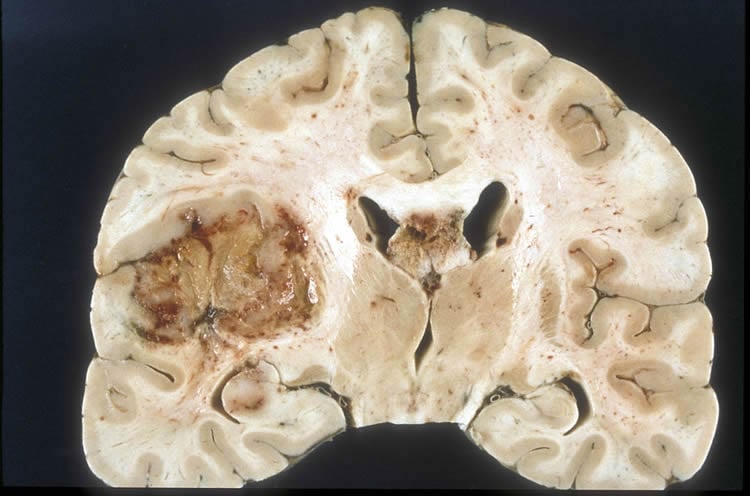Summary: Researchers discover a mechanism that may underpin the progression of glioblastoma brain cancer development.
Source: University of Edinburgh.
Researchers have pinpointed two key molecules that drive the growth of an aggressive type of adult brain cancer.
The findings shed light on the mechanisms that underpin brain cancer progression and could eventually reveal targets for the development of much-needed therapies, researchers say.
Scientists conducted lab tests on tumour cells from patients with glioblastoma, a rare but aggressive type of brain cancer.
Previous studies have found that glioblastoma cells share similarities with normal brain stem cells, which give rise to the many different cell types in the brain during development.
The team identified two molecules that are produced at high levels by the cells – called FOXG1 and SOX2.
Similar levels of these molecules are found in brain stem cells and are a defining feature of these cells.
The researchers found that SOX2 drives glioblastoma cells to keep dividing, a hallmark of cancer.
FOXG1 stops the cells from responding to other signals that would usually point them towards becoming specialised, the team found.
Both FOXG1 and SOX2 work by controlling when key target genes are switched on and off by the cell.
The researchers analysed which genes were affected and identified several factors that are involved in controlling cell division.
The insights could open the door to new therapies that stop or slow tumour growth, the researchers say.
Glioblastoma is a fast-growing type of brain tumour. There are few options for treatment and only one in five patients will survive more than one year after diagnosis.
The study was led by scientists at the Medical Research Council Centre for Regenerative Medicine at the University of Edinburgh. The research is published in Genes and Development and was funded by Cancer Research UK and the Wellcome Trust.
Lead researcher Dr Steve Pollard, CRUK Senior Cancer Research Fellow at the University of Edinburgh, said: “Brain cancer cells seem to be hijacking important cell machinery that is used by normal brain stem cells. The tactic they appear to use is to produce high levels of these key regulators. This locks the tumour cells into perpetual cycles of growth and stops them listening to the signals that normally control cell specialisation.”

Dr Áine McCarthy, Cancer Research UK’s Senior Science Information Officer, said: “While survival for many types of cancer have improved dramatically, tackling brain tumours remains a challenge and we urgently need to develop new, kinder treatments.
“This research provides an exciting new insight into how two specific molecules might play a key role in driving the growth of glioblastoma tumours, the most common type of brain tumour. The next step will be for scientists to see if they can develop a way to stop glioblastoma cells from using these molecules as a way to survive and then to test it in clinical trials to see whether this affects tumour growth in people.”
Source: Jen Middleton – University of Edinburgh
Image Source: NeuroscienceNews.com image is in the public domain.
Original Research: Abstract for “Elevated FOXG1 and SOX2 in glioblastoma enforces neural stem cell identity through transcriptional control of cell cycle and epigenetic regulators” by Harry Bulstrode, Ewan Johnstone, Maria Angeles Marques-Torrejon, Kirsty M. Ferguson, Raul Bardini Bressan, Carla Blin, Vivien Grant, Sabine Gogolok, Ester Gangoso, Sladjana Gagrica, Christine Ender, Vassiliki Fotaki, Duncan Sproul, Paul Bertone, and Steven M. Pollard in Genes and Development. Published online May 2 2017 doi:10.1101/gad.293027.116
[cbtabs][cbtab title=”MLA”]University of Edinburgh “Brain Cancer Discovery Reveals Clues in Quest For New Therapies.” NeuroscienceNews. NeuroscienceNews, 10 May 2017.
<https://neurosciencenews.com/brain-cancer-therapies-6639/>.[/cbtab][cbtab title=”APA”]University of Edinburgh (2017, May 10). Brain Cancer Discovery Reveals Clues in Quest For New Therapies. NeuroscienceNew. Retrieved May 10, 2017 from https://neurosciencenews.com/brain-cancer-therapies-6639/[/cbtab][cbtab title=”Chicago”]University of Edinburgh “Brain Cancer Discovery Reveals Clues in Quest For New Therapies.” https://neurosciencenews.com/brain-cancer-therapies-6639/ (accessed May 10, 2017).[/cbtab][/cbtabs]
Abstract
Elevated FOXG1 and SOX2 in glioblastoma enforces neural stem cell identity through transcriptional control of cell cycle and epigenetic regulators
Glioblastoma multiforme (GBM) is an aggressive brain tumor driven by cells with hallmarks of neural stem (NS) cells. GBM stem cells frequently express high levels of the transcription factors FOXG1 and SOX2. Here we show that increased expression of these factors restricts astrocyte differentiation and can trigger dedifferentiation to a proliferative NS cell state. Transcriptional targets include cell cycle and epigenetic regulators (e.g., Foxo3, Plk1, Mycn, Dnmt1, Dnmt3b, and Tet3). Foxo3 is a critical repressed downstream effector that is controlled via a conserved FOXG1/SOX2-bound cis-regulatory element. Foxo3 loss, combined with exposure to the DNA methylation inhibitor 5-azacytidine, enforces astrocyte dedifferentiation. DNA methylation profiling in differentiating astrocytes identifies changes at multiple polycomb targets, including the promoter of Foxo3. In patient-derived GBM stem cells, CRISPR/Cas9 deletion of FOXG1 does not impact proliferation in vitro; however, upon transplantation in vivo, FOXG1-null cells display increased astrocyte differentiation and up-regulate FOXO3. In contrast, SOX2 ablation attenuates proliferation, and mutant cells cannot be expanded in vitro. Thus, FOXG1 and SOX2 operate in complementary but distinct roles to fuel unconstrained self-renewal in GBM stem cells via transcriptional control of core cell cycle and epigenetic regulators.
“Elevated FOXG1 and SOX2 in glioblastoma enforces neural stem cell identity through transcriptional control of cell cycle and epigenetic regulators” by Harry Bulstrode, Ewan Johnstone, Maria Angeles Marques-Torrejon, Kirsty M. Ferguson, Raul Bardini Bressan, Carla Blin, Vivien Grant, Sabine Gogolok, Ester Gangoso, Sladjana Gagrica, Christine Ender, Vassiliki Fotaki, Duncan Sproul, Paul Bertone, and Steven M. Pollard in Genes and Development. Published online May 2 2017 doi:10.1101/gad.293027.116







